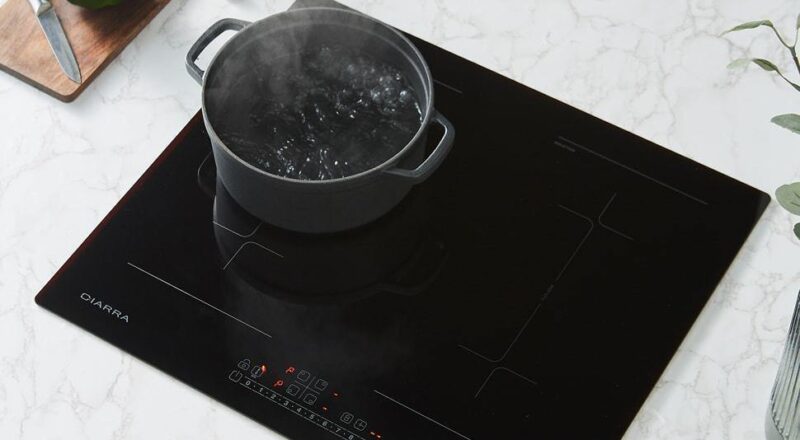When it comes to preparing holiday meals, the choice of cookware can make all the difference. Many home cooks and professionals alike are turning to cast iron for holiday meals on induction cooktops due to its excellent heat retention and distribution. This versatile combination promises to elevate your festive cooking experience by ensuring perfectly cooked dishes every time.
The use of cast iron in holiday meals is not new, but its compatibility with induction cooktops opens up new possibilities for home chefs. This article will guide you through the benefits, tips, and techniques for using cast iron on induction cooktops, ensuring your holiday meals are both memorable and delicious.

Why Choose Cast Iron for Holiday Meals?
Cast iron cookware is renowned for its ability to maintain consistent heat, which is essential for preparing large holiday meals. Whether you’re searing a roast or simmering a stew, cast iron ensures even cooking, preventing hot spots that can lead to unevenly cooked food.
Benefits of Cast Iron on Induction Cooktops
Using cast iron on induction cooktops combines the best of both worlds. Induction technology offers precise temperature control, while cast iron provides the robust heat retention needed for successful cooking. This synergy results in energy-efficient cooking, saving time and reducing energy costs during the busy holiday season.
Additionally, cast iron is incredibly durable and can last a lifetime with proper care. This makes it a sustainable choice, ideal for those looking to invest in high-quality cookware.
Preparing Your Cast Iron for Induction Cooking
Before using your cast iron cookware on an induction cooktop, ensure it is clean and well-seasoned. A well-seasoned pan will have a natural non-stick surface, crucial for preventing food from sticking during cooking. Regular seasoning also protects the pan from rust, extending its lifespan.
Ensure that the bottom of the cast iron pan is flat and in contact with the induction cooktop surface. This ensures maximum efficiency and even heat distribution. If you experience issues like uneven heating, consider adjusting the pan or using a different size that matches the induction ring.
Cooking Techniques for Holiday Meals
Roasting in Cast Iron
One of the most popular uses of cast iron during the holidays is for roasting. Whether it’s a turkey, chicken, or beef roast, cast iron provides the even heat necessary for a perfect roast. Preheat both the pan and the cooktop to ensure the meat is seared properly, locking in juices and flavors.
Sauting Vegetables
Sauting vegetables in cast iron is quick and efficient on an induction cooktop. The precise temperature control allows you to cook delicate vegetables without burning, preserving their nutrients and flavors. Use a small amount of oil to prevent sticking and enhance the taste.
Baking in Cast Iron
Beyond traditional stovetop cooking, cast iron can also be used for baking. From cornbread to pies, the heat retention properties of cast iron ensure an evenly baked crust. Preheat the pan in the oven before adding your batter or dough for best results.
Common Challenges and Solutions
Dealing with Cold Spots
If your cast iron cookware develops cold spots, it could affect the cooking process. Make sure the pan size matches the induction ring size. Read more about this in our guide on cold spots.
Handling Smoky Cookware
Sometimes, cast iron can become smoky when used on induction cooktops. This is often due to overheating or insufficient seasoning. For tips on preventing this, visit our article on smoky cookware.
Frequently Asked Questions
Can I use any cast iron on induction cooktops?
Yes, most cast iron cookware is compatible with induction cooktops. The iron content in the cookware is what allows it to work with the magnetic field generated by induction, ensuring effective cooking.
How do I prevent sticking in cast iron?
To prevent sticking, ensure your cast iron pan is well-seasoned. This creates a natural non-stick layer. Also, preheat the pan before adding food, and use a small amount of oil to enhance its non-stick properties.
What should I do if my cast iron pan doesn’t heat evenly?
Ensure that the pan is flat and in full contact with the induction cooktop. If issues persist, try using a pan that matches the size of the induction ring to prevent uneven heating.
For more insights on this topic, visit this external resource.

Conclusion
Using cast iron for holiday meals on induction cooktops offers a blend of tradition and modern technology, ensuring your festive meals are cooked to perfection. With the right techniques and care, cast iron can elevate your holiday cooking, providing delicious and memorable meals for you and your loved ones.
This article contains affiliate links. We may earn a commission at no extra cost to you.

